MCAT p/s 1 - Sensory Perception (Vision, Audition, Olfaction) and Drugs
1/193
There's no tags or description
Looks like no tags are added yet.
Name | Mastery | Learn | Test | Matching | Spaced |
|---|
No study sessions yet.
194 Terms
Visual cues
allows us to perceptually organize by taking into account the following cues: depth, form, motion, constancy
depth, form, motion, constancy
Visual cues
Retinal disparity
Eyes are ~2.5 inches apart which allows humans to get slightly different views of objects of world around. Gives humans an idea on depth
depth
Binocular cues give a sense of ______
Convergence
Gives humans an idea of depth based on how much eyeballs are turned
relaxed
Convergence
Things far away–muscles of eyes ______
contract
Convergence
Things close to us–muscles of eyes _______
Monocular cues
Humans also have visual cues they receive which they do not need two eyes for
These give humans a sense of form of an object
Relative size, interposition, relative height, shading and contour
Give sense of constancy
Size, shape, colour constancy
Give sense of motion
Motion parallax
form, motion, constancy
Monocular cues give sense of
Relative size
Monocular cue
an infer with one eye
The closer an object it is perceivedas being bigger
Gives us an idea of form
Interposition (overlap)
Monocular cue
Perception that tone object is in front of another
An object that is in the front is closer
Relative height
Monocular cue
things higher are perceived to be farther away than those that are lower
Shading and contour
Monocular cue
using light and shadows to perceive form depth/contours–crater/mountain
Motion parallax
Monocular cue
“relative motion” Things farther away move slower, closer moves faster
Constancy
Monocular cue
Our perception of object doesn’t change even if the image cast on the retina is different.
Size, shape, color
Sensory adaptation
Our senses are adaptable and they can change their sensitivity to stimuli
contract
Sensory adaptation
Hearing adaptation-inner ear muscle: higher noise = muscle ____ (this dampens vibrations in inner ear, protects ear drum.)
desensitize
Sensory adaptation - touch and smell receptors ______ over time
Proprioception
the sense of the position of the body in space i.e.“sense ofbalance/where you are in space
Down regulation
Sensory adaptation to light
light adaptation
When it is bright out, pupils constrict (less light enters back of eye), and the desensitization of rods and cones become desensitized to light)
Up regulation
Sensory adaptation to light
dark regulation
Pupils dilate-, rods and cones start synthesizing light sensitive molecules
just noticeable difference (JND)/difference threshold
The threshold at which you’re able to notice a change in any sensation
smallest difference that can be detected 50% of the time
deltaI = Ik
Weber’s Law
Weber’s Law
ΔI (JND)/I (initial intensity) = k (constant)
predicts alinear relationshipbetween incremental threshold and background intensity.
Absolute threshold of sensation
The minimum intensity of stimulus needed to detect a particular stimulus 50% of the time
Different that JND/difference threshold
This is about intensity, JND is about difference in intensity
Can change, influenced by:
Expectations
Experience
Motivation
Alertness
Subliminal stimuli
stimuli below the absolute threshold of sensation
Somatosensation
the sense of touch, encompasses all sensations received from the skin, mucous membranes, limbs, and joints
Receive info about type, intensity, timing, and location
Location relies on dermatomes
Thermoception
Temperature Somatosensation
Slow
Relies on TrypV1 receptor
Heat causes conformational change in the protein that activates cell and sends signal to brain
Mechanoception
Pressure Somatosensation
Nociception
Pain Somatosensation
slow
Proprioception
Position Somatosensation
Intensity
how quickly neurons fire for us to notice. Slow =low intensity, fast = highintensity
Non-adaptive
Timing for somatosensation
neuron consistency fires at a constant rate
Slow-adapting
Timing for somatosensation
neuron fires in beginning of stimulus and calms downafter awhile
Fast-adapting
Timing for somatosensation
neuron fires as soon as stimulus start...then stopsfiring. Startsagain when stim stops)
Vestibular system
For balance and spatial orientation
Inner ear, particularly semi-circular canals
Endolymph
Semi-circular Canal is filled with ________, and when we rotate the fluid shifts in the semi circular canals–allows us to detect what direction our head is moving in, and because we can detect how quickly the _______ is moving we can determine the strength of rotation
Otolithic organs (utricle and saccule)
help us to detect linear acceleration and head positioning
In these are CaCO3 (Calcium carbonate) crystals attached to hair cells in viscous gel
If we go from lying down to standing up, they move, and pull on hair cells,which triggers AP.
These would not work very well w/o gravity! Buoyancy can haveeffects as well, particularly without visual cues on which way is up/down
Signal Detection Theory
Looks at how we make decision under conditions of uncertainty
Discerning between important stimuli and unimportant “noise
Options: hit/miss/false alarm/correct rejection
>, <
Strength (d’) in signal detection theory
hit __ miss (when there is strong signal)
hit __ miss (weak signal)
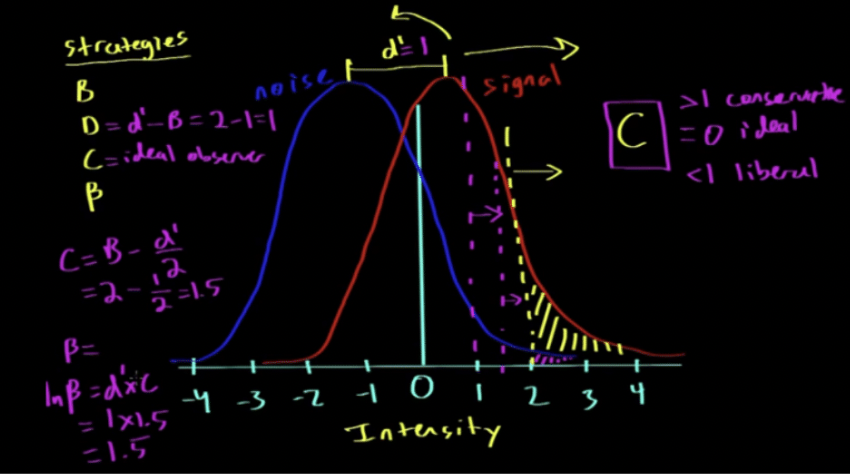
Strategy (c)
Seen as a threshold
Want to minimize miss and false alarm
When C = 0, participant is ideal observer. If <1 - liberal. If >1 - conservative
Beta strategy
set value of threshold to the ratio of height of signal distribution to height of noise distribution
i.e. ln ___ = d’ x C = 1 x 1.5 = 1.5. So e^1.5 = beta= 4.48
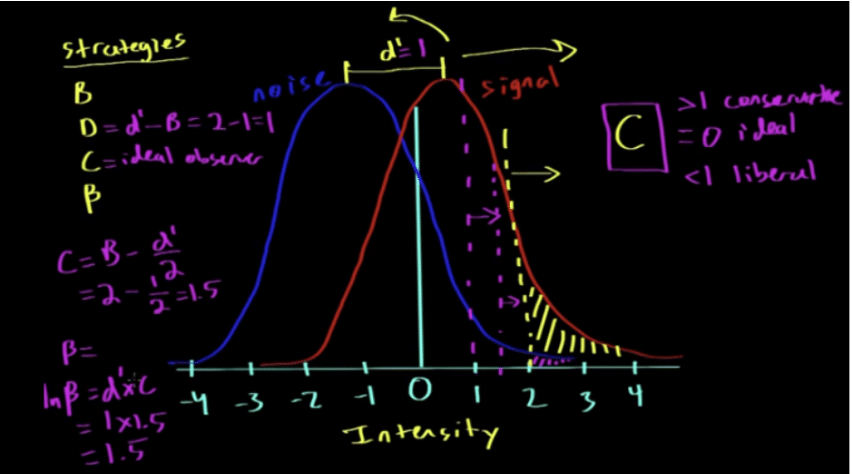
Strength (d’)
Difference between the means or noise and signal distribution
So if signal shifted to right, d’would be big and easyto detect. If left, d’ very small and more difficult to detec
Conservation strategy
Strategy (c) in signal detection theory
always say no unless 100% sure signal ispresent. Bad thing is might get some misses
Liberal strategy
Strategy (c) in signal detection theory
always sayyes, even if get false alarms
Bottom up Processing
Begins with stimulus. Stimulus influences what we perceive
No preconceived cognitive constructs of the stimulus (never seen it before)
Data driven. And the stimulus directs cognitive awareness of what you’re lookingat (object)
InductiveReasoning. Always correct
Top-down Processing
uses background knowledge influences perception
Theory driven
Perception influenced by our expectation
DeductiveReasoning
ex.creating a cube when it’s not there! Not always correc
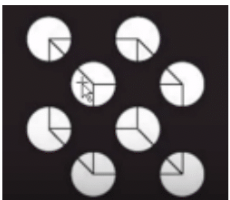
Gestalt Principles
Tries to explain how we perceivethings the way we do
Similarity, Pragnanz, Proximity, Continuity, Closure, Symmetry
Similarity
Gestalt Principle
items similar to one another grouped together by brain
Ex:The brainautomatically organizes these squares and circles in columns, and not in rows
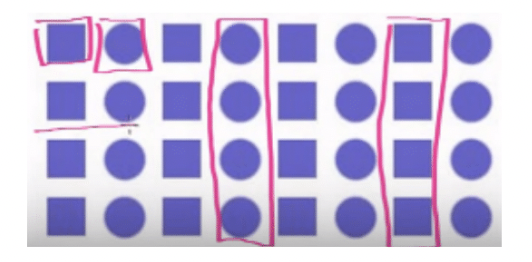
Pragnanz
Gestalt Principle
Reality organized reduced to simplest form possible.
Ex. Olympic rings, where the brain automatically organizes these into 5 circles, instead of more complex shapes
Proximity
Gestalt Principle
objects that are close are grouped together,we naturally group the closerthings together rather thanthings that are farther apart.
Continuity
Gestalt Principle
lines are seen as following the smoothestpath
Closure
Gestalt Principle
objects grouped together are seen as a whole. Mind fills inmissing information.
Ex. You fill in the triangle even though there is none
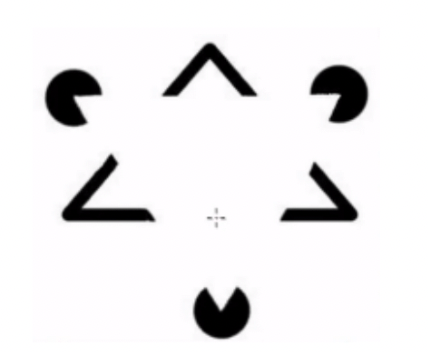
Symmetry
Gestalt Principle
the mind perceives objects as being symmetrical and forming around acenter point
Law of Common Fate
Gestalt Principle
elements moving together in the same direction or at the same speed are perceived as a group
For example, if there are an array ofdots and half the dots aremoving upward while the other half are moving downward, we would perceive theupward moving dots and the downward moving dots as two distinct units.
Law of Past Experiences
Gestalt Principle
Under somecircumstances visual stimuli are categorized according to past experience
If two objectstend to be observed within close proximity, or small temporal intervals, the objects aremore likely to be perceived together.
or example, the English language contains 26letters that are grouped to form words using a set of rules. If an individual reads anEnglish word they have never seen, they use the law of past experience to interpret theletters "L" and "I" as two letters beside each other, rather than using thelaw of closureto combine the letters and interpret the object as an uppercase U
Contextual effects
Gestalt Principle
the context in which stimuli are presented and the processes ofperceptual organization contribute to how people perceive those stimuli (and also that the context can establish the way in which stimuli are organized
Conjunctiva
Part of the eye
thin layer of cells that lines the inside of your eyelids from the eye
Cornea
Part of the eye
transparent thick sheet of fibrous tissue, anterior 1/6th; starts to bends light, first part of eye light hits
Anterior chamber
Part of the eye
space filled with aqueous humour, which provides pressure to maintain shape of eyeball; allows nutrients and minerals to supply cells of cornea/iris.
Pupil
Part of the eye
opening in the middle of the iris
The size can get bigger/smaller based on the iris relaxing/contracting respectively
Modulates the amount of light able to enter the eyeball
Iris
Part of the eye
Gives the eye color
The muscle that constricts/relaxes to change the size of the pupil
Lens
Part of the eye
bends the light so it goes to back of eyeball–focuses light specifically on the fovea of the retina
Adjust how much it bends the light by changing its shape, using thesuspensory ligaments
Suspensory ligaments
Part of the eye
attached to a ciliary muscle
These two things together form theciliary body, what secrets the aqueous humor
Posterior chamber
Part of the eye
area behind the iris to the back of lens; also filled with aqueous humor
Vitreous chamber
Part of the eye
filled with vitreous humour, a jelly-like substance to provide pressure to eyeball and gives nutrients to inside of eyeball
Retina
Part of the eye
inside, back area filled with photoreceptors, where the ray of light is converted from a physical waveform to a electrochemical impulse that the brain can interpret
Macula
Part of the eye
special part of retina rich in cones, but there are also rods
Fovea
Part of the eye
Special part of macula
Dimple of the retina
Light hits ___ more directly bcs no axons in the way - allows for higher resolution
Completely covered in cones,no rods.
*Rest of the retina is covered in primarily rods
Choroid
Part of the eye
pigmented black in humans, is a network of blood vessels that helps nourish the retina
If black all light is absorbed.
Some animals have a different colored choroid which gives them better night vision
Sclera
Part of the eye
Usually absorbs by the time the light gets to this
The whites of the eye, thick fibrous tissue that covers posterior 5/6th of eyeball(cornea covers the anterior 1/6)
Attachment point for muscles
Extra layer of protection and structure of eyeball
Lined with the conjunctiva.
Rod
Photoreceptor - Detect light
Night vision
120 million
More sensitive
Mostly on periphery of retina
Slow recovery time - takes longer to adjust to the dark
Light comes in, goes through pupil, and hits ___. Normally __ is turned on, but when light hits turns off
When ___ is off, it turns on a bipolar cell, which turns on a retinal ganglion cell, which goes into the optic nerve and enters the brain
Cone
Photoreceptor - detect color and discern high level of detail
6-7 million
Less sensitive
Fast recovery time - adapt to changes faster/fire more frequently
3 types: red, green, blue
Mostly on fovea (center of macula)
Transmisson
electrical activation of one neuron by another neuron
Perception
conscious sensory experience of neural processing
Processing
neural transformation of multiple neural signals into a perception
Transduction
Occurs whenever E is transformed from one form to another
Light E to electrical E by rods and cones
Sensation
requires a physical stimulus to be converted into a neural impulse
Light
Electromagnetic wave
In the middle of EM spectrum
Violet (400nm)–Red (700nm). Highest to lowest wavelength: ROYGBV
Sun = most common source
Phototransduction cascade
what happens when light hits rod/cone
Light hits rods (which causes rod turns off, turns light into a neural impulse) → bipolar cell (on center turns on, off center turns off) → retinal ganglion cell (turns on on center) → optic nerve → BRAIN
The phototransduction cascade is the process of rod turning from ON to OFF
Rhodopsin
Protein in optic disks of rods
Multimeric protein with 7 discs
Contains retinal
Photopsin
Protein in optic disks of cones
Multimeric protein with 7 discs
Contains retinal
Retinal
Molecule in rhodopsin and photopsin
When light hits, changes conformation (cis → trans, bent → straight)
Changes conformation of rhodopsin/photopsin
Begins phototransductase cascade
Light → rod (off) → bipolar cell (on) → ganglion cell (on) → optic nerve → brain
Order of phototransduction cascade
Bipolar cells
In retina
Send visual signals from rods and cones to ganglion cells
Ganglion cells
In retina
Receive signals from bipolar cells and send to optic nerve
Optic nerve
Receive signals from ganglion cells
Signals brought to brain
Axons of ganglion cells
Blind spot
Trichromatic Theory of Color Vision
3 cones in eyes
Red, Green, Blue
Combine to make all the colours that you see
But, can’t seem to mix red/green and blue/yellow
Opponent process theory of color vision
4 colours in pairs that are opponents, can only see one of the two at a time
Red vs Green
Blue vs Yellow
Black vs White
Photopic
___________ vision occurs at high light vision
Mesopic
___________ vision occurs at dawn or dusk and involves both rods and cones
Scotopic
___________ vision occurs at levels of very low light
nasal, temporal
Ray of light from the left visual field hits the _____ side of the left eye and hits the ______ side of the right eye
nasal, temporal
Ray of light from the right visual field hits the _____ side of the right eye and hits the ______ side of the left eye
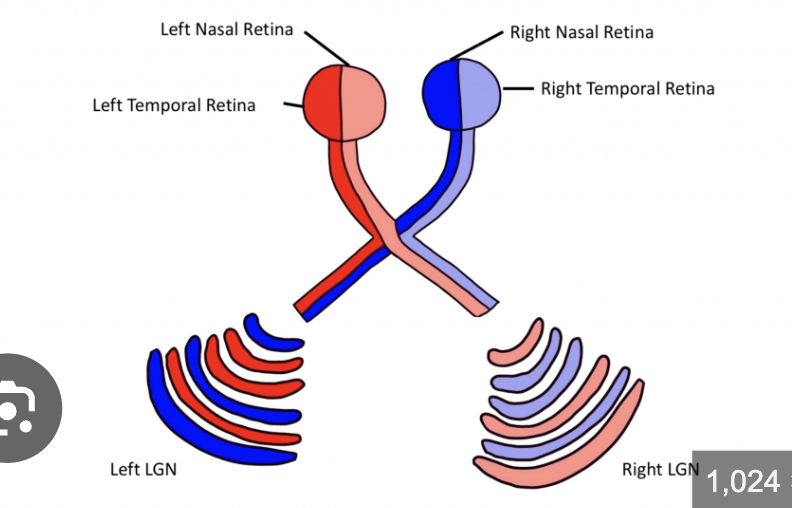
Optic chiasm
Where the optic nerves from each eye networks the electrical signal to the brain and converge from each eye and then break off and dig deeper into the brain
All light from nasal side of eyes crosses to the other side
Left nasal to right side of brain
All axons on temporal side DO NOT cross over
color, form, motion
In feature detection, must consider three things when looking at an object
Parvocellular pathway
For form detection
good at spatial resolution (boundaries and shape—high levels of details),and color
But poor temporal (can’t detect motion—only stationary.)
Cones responsible
Pink pyramid
Magnocellular pathway
For motion detection
has high temporal resolution (think time, motion) resolution [encodes motion]
But has poor spatial resolution; no color)
Rods responsible
60, 30, 10
Cones
Red - __%
Green - __%
Blue - __%
Wavelength
How close peaks are
Inversely proportionate to frequency
Higher ______ (smaller frequency)= travel farther = penetrate deeper into the cochlea